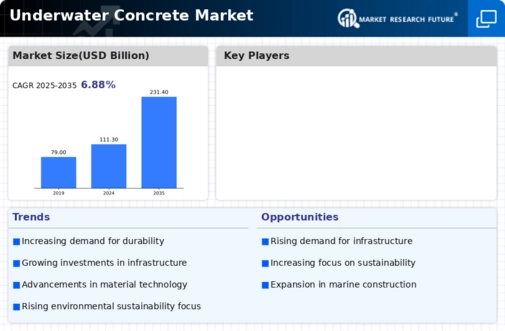Top Industry Leaders in the Underwater Concrete Market
 The underwater concrete market is a submerged but burgeoning landscape where industry titans and agile innovators battle for market share. To navigate this complex terrain, let's dive deep into the competitive strategies, market-defining factors, recent industry news, and the latest developments that have been shaping the underwater concrete Market.
The underwater concrete market is a submerged but burgeoning landscape where industry titans and agile innovators battle for market share. To navigate this complex terrain, let's dive deep into the competitive strategies, market-defining factors, recent industry news, and the latest developments that have been shaping the underwater concrete Market.
Key Strategies Driving Market Share:
-
Product Differentiators: Leading players like Cemex and HeidelbergCement are investing heavily in R&D to develop self-compacting, fiber-reinforced underwater concretes with enhanced durability and resistance to corrosion. These advancements open doors to new applications and differentiate offerings. -
Technological Prowess: Embracing automation and robotics empowers companies like Sika and Conmix to minimize human intervention in underwater construction, improving safety and efficiency while reducing dependence on skilled divers. -
Regional Expansion: Targeting markets with burgeoning infrastructural needs, especially in Asia and the Middle East, allows companies like Five Star Product to expand their reach and capture new customer segments. -
Sustainability Focus: Addressing environmental concerns, companies are exploring eco-friendly underwater concrete mixes with lower carbon footprints and incorporating recycled materials. This resonates with environmentally conscious clients and aligns with global sustainability goals. -
Strategic Partnerships: Collaborations between cement giants and construction firms leverage each other's expertise and resources, enabling them to tackle complex underwater projects and secure large-scale contracts.
Factors Defining Market Share:
-
Infrastructure Demand: Rising investments in marine infrastructure projects like offshore wind farms, bridges, and tunnels fueled by urbanization and renewable energy growth drive the demand for underwater concrete. -
Technological Advancements: Innovations in underwater placement techniques, monitoring systems, and material science optimize construction processes and increase project feasibility. -
Regional Dynamics: Varied economic landscapes and environmental regulations across different regions create diverse market growth patterns. Asia is predicted to be the fastest-growing market due to its ambitious infrastructure plans. -
Regulations and Standards: Stringent regulations regarding environmental impact and construction safety influence the choice of materials and techniques, impacting market dynamics. -
Cost Considerations: While offering long-term cost benefits, the initial high cost of underwater concrete compared to traditional methods can hinder its adoption in some projects.
Key Players
- Sika AG (Switzerland)
- Cemex S.A.B. De C.V. (Mexico)
- Rockbond SCP Ltd (UK)
- Conmix Ltd (United Arab Emirates)
- HeidelbergCement Group (Germany)
- M-Con Products Inc (U.S.)
- Underground Supply Inc (U.S.)
- Wieser Concrete Products Inc (U.S.)
Recent Developments :
September 2023: Concerns arise regarding the potential environmental impact of underwater concrete production, prompting industry players to invest in greener solutions and research alternatives.
October 2023: A consortium of leading companies wins a bid to build a major underwater tunnel project in Japan, showcasing the collaborative approach emerging in the market.
November 2023: The International Union for Materials Research and Testing publishes new guidelines for underwater concrete testing and quality control, promoting standardization across the industry.
December 2023: Governments in several European countries announce plans to incentivize the use of underwater concrete in renewable energy projects, boosting market demand.

